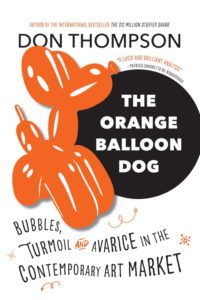Really, the word “art” barely even has any place in that headline, or in the scene that The Orange Balloon Dog: Bubbles, Turmoil and Avarice in the Contemporary Art Market documents. In the book, author Don Thompson—who has several books to his name, all focusing on the same theme—shows how the modern contemporary art world is basically—and these are my words—hopelessly empty, devoid of any appreciation for art whatsoever, and more or less a swirling cesspool of dead-soul investors with dollar signs in their eyes spending exorbitant prices on pieces of “art” produced with the intention of becoming nothing more than investment pieces collecting dust in a storage space. I mean, it’s enough to make the reader want to run screaming into the nearest forest. But, despite the despair that reading about this world will bring into the life of any sane human, the book is a fascinating and highly recommended read.
Thompson approaches his analysis with the mind of an economist, looking at how the contemporary art world has no precedent in economics, does not operate with any logic to it, and is a bubble just waiting to burst. He talks about various controversies within art, from auction-house manipulation to the extremely interesting phenomenon of “freeports” at airports, where people can store art without having to pay tax on them.
At least here in Canada we’re relatively removed from all this absurdity. For example, Thompson says that the yearly amount spent litigating and settling art-ownership disputes in courts in New York City alone (alone!), at a lowball estimate, is more than the value of annual art sales here in the entirety of Canada. Think about it.
What Thompson is too professional to say in his book (although his disdain comes through clenched teeth pretty loud and clear) is that this is all horrible, and the whole scene—investors flipping art for profit, storing it in warehouses, artists making customers sign off on pre-sale purchase contracts that clearly place more value on finance than on art—is an insult to actual artists worldwide, who might take the time to laugh it all off if they weren’t too busy actually making actual art to even care about this kind of rubbish.
It’s all endlessly frustrating to learn about, but this fascinating and eye-opening book is definitely worth reading.

